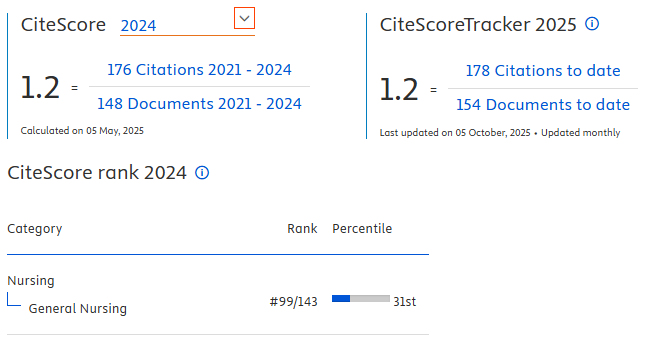Technical Indicators of Cardio-Pulmonary Resuscitation (Cpr) with Traveling Time 20, 40 and 60 Km/H
Downloads
Methods: Design used in this study was pre-experiment. The population were nurses in ambulances 118 of Dr. Soetomo hospital Surabaya. A total of 14 respondents were taken as samples by purposive sampling. The independent variable was effectiveness of traveling time, while the dependent variable were technical indicators of CPR: Tidal Volume (TV), landmark hand position, deep of chest compression and chest compression rhythm in manekin. Data were measured by observation sheet and then analyzed using Chi-square test with level of significance α ≤ 0.05.
Result: The result showed that travelling time 20 km/h and 40 km/h had a significant effect on technical indicators of CPR, but not at 60 km/h.
Conclusion: It could be concluded, the faster the travelling time, the more difficult to perform CPR. Further study should involve the travelling time and the accuracy of CPR technical indicators to treat and safe the patients, either in traumatic or non traumatic case.
Karjono, J., 1991. Cermin Dunia Kedokteran. Surabaya: UPF Ilmu Penyakit Jantung FKUA, hlm. 37–39.
Lars , W. et al . , 2 0 0 5 . Quality of Cardiopulmonary Resuscitation During Out of Hospital Cardiac Arrest, (Online), (http://jama.ama-assn.org/cgi/content/full/293/3/299, diakses tanggal 22 Oktober 2008 jam 08.00 WIB).
Presiden, Republik Indonesia, 1992. Lalu Lintas dan Angkutan Jalan, (Online), (http://www.lantas.polri.go.id/vademikum/vademikum-kapita-bab-III.pdf, diakses tanggal 22 Oktober 2008 jam 08.18 WIB).
Simovic, V., 2007. Ambulans Pra Rumah Sakit., (Online), (http://agddki.blogsome.com/, diakses tanggal 22 Oktober 2008 jam 08.20 WIB).
RSUD Dr. Soetomo dan FK UNAIR, 2008. Materi pelatihan GELS (General Emergency Life Support). Surabaya: RSUD Dr Soetomo dan FK UNAIR.
Authors who publish with Jurnal Ners agree to the following terms:
- Authors transfer the Copyright and grant Jurnal Ners the right of first publication with the work simultaneously licensed under a Creative Commons Attribution 4.0 International License that allows others to remix, adapt and build upon the work with an acknowledgment of the work's authorship and of the initial publication in Jurnal Ners.
- Authors are permitted to copy and redistribute the journal's published version of the work (e.g., post it to an institutional repository or publish it in a book), with an acknowledgment of its initial publication in Jurnal Ners.
Jurnal Ners requires a formal written declaration and transfer of copyright from the author(s) for each article published. We, therefore, ask you to complete and return this form, retaining a copy for your own records. Your cooperation is essential and appreciated. Any delay will result in a delay in publication. The form can be downloaded HERE.
































